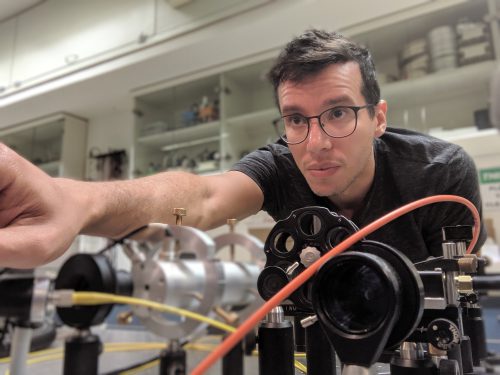For the first time, researchers from the Hebrew University led by Prof. Ronan Rappaport, in collaboration with Prof. Maxim Khudas and collaborators from Princeton University in the USA, found evidence for the existence of a stable quantum liquid based on "excitons" (like particles made of electrons in a crystal), and developed a theoretical model that explains this phenomenon. The discovery changes the old paradigm that cold electron liquids of this type do not generate a stable superfluid. Thanks to those particle-like particles, it is possible to create the quantum liquid on a chip and investigate whether it behaves as a "superfluid", thus building in the future sensors that are highly used in sensitive measurements and even help in the discovery of the dark matter

For the first time, researchers from the Hebrew University led by Prof. Ronan Rappaport, in collaboration with Prof. Maxim Khudas and partners from Princeton University in the USA, found evidence for the existence of a stable quantum liquid based on "excitons" (like particles made of electrons in a crystal), and developed a theoretical model that explains this phenomenon. The discovery changes the old paradigm that cold electron liquids of this type do not generate a stable superfluid. Thanks to those particle-like particles, it is possible to create the quantum liquid on a chip and investigate whether it behaves as a "superfluid", thus building in the future sensors that are highly used in sensitive measurements and even help in the discovery of dark matter.
Friction is an almost inevitable phenomenon in nature. The movement of surfaces, swirling liquids or the flow of charges tend to slow down and lose energy to heat as a result of bending and friction of the material with its environment. Despite the deep familiarity with such phenomena, nature has taught scientists that extreme conditions may produce phenomena that contradict basic intuition. Thanks to discoveries that began with Einstein, quantum mechanics shows that at temperatures close to absolute zero, special materials lose the property of friction and allow energy to flow through them without being lost to heat. As a result, they express unique "super" properties that eliminate the material's electrical resistance or liquid viscosity. The quantum phenomenon that has intrigued researchers for decades yields rich research in the understanding of many-body physical phenomena and may even decipher the nature of dark matter. In front of the academic level, scientific research may lead to technological breakthroughs in favor of precise measurements and enormous energy savings.
In order for scientists and industrialists to be able to research and utilize the "super" properties of materials, they need the ability to manipulate them and make them user-friendly. The technological hope is to create a liquid inside an electronic chip so that its flow can be controlled, it can be used in microelectronic devices, and its properties can be monitored under the effects of the environment. One of the possibilities to create such a chip is with the help of particle-like excitons that express properties of a quantum liquid at low temperatures. The problem with such systems is that excitons are not stable particles and only exist for a short fraction of a few billionths of a second. The use of excitons to produce this stable quantum liquid over time has been considered a scientific and technological challenge for years. About a decade ago, a groundbreaking theoretical idea was published that claimed that a state of quantum liquid based on "dark" excitons might exist. These are called dark because they are unable to emit light when they disappear from the material (as opposed to "illuminated" excitons that emit light). The quantum property allows the dark excitons to exist for a much longer time than those capable of emitting light. That hope was quickly dashed, because newer theoretical models predicted that the dark quantum liquid is so delicate and fragile that it hardly exists in the laboratory. The fragility results from collisions between the particles in the quantum liquid that quickly change the exciton from "dark" to "bright".
The scientific community did not believe that a stable quantum liquid could indeed be predicted in such a system. In a recently published study By the researchers from the Hebrew University and their partners from Princeton University in the scientific journal "Proceedings of the National Academy of Science" Evidence was observed for the existence of the exciton-based quantum liquid in stability and density several orders of magnitude greater than theoretical predictions. The researchers explained the existence of the stable superfluid thanks to long-range interactions, unlike the conventional theory that excitons affect each other in short-range interactions, that is, only when they are very close. The researchers also provided a theoretical explanation for the surprising phenomenon - "The old predictions were based on a powerful phenomenon of spin-changing collisions that affect the concentration of the dark and light excitons," says Prof. Ronen Rappaport, "but in the new system we created special particle-like particles with long-range interactions, and we showed that such interactions , in which the particles feel and repel each other electrically from great distances, causing a significant reduction in the collisions from the spin changes, thereby drastically stabilizing the dark state.'
Now that they have shown that it is possible to create a stable quantum liquid on a chip, the next step is to directly measure the "superfluid" properties of the system and take advantage of the conductivity and locality of the superfluid for industrial uses in the transmission of information, in the efficient transmission of energy, and in performing precise measurements to locate and detect elusive phenomena In physics like for example the dark matter. Prof. Rappaport's laboratory was able to demonstrate in the past on a number of devices the ability to control complex flow of exciton fluids with the help of electrical, optical, and acoustic manipulations, thereby advancing the creation of these devices and sensors to another step.

Yotam Mazuz-Harpaz, a PhD student in Prof. Ronan Rappaport's research group adds: "It's very exciting. Over the course of several years, we and other researchers from around the world accumulated experimental results that we didn't quite know how to interpret and that sometimes seemed to contradict each other. It seems that this study finally provides a consistent and unified explanation for all these observations. It also sheds new light on what awaits us later in the journey to a complete understanding of systems of this type and harnessing them for uses in the technologies of the future"
More of the topic in Hayadan:

One response
Excellent!
Glad to hear about groundbreaking research in the Israeli industry, it is not for nothing that we are said to be the startup nation and world leader.